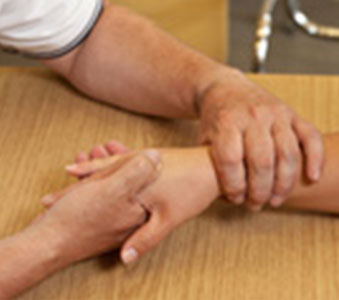At one point in time or another, everyone has had a minor injury to a finger, hand, or wrist that caused pain or swelling. The risks of such injuries are commonly seen in contact sports such as football, hockey and soccer.
Scaphoid fracture
One injury that is often overlooked is a scaphoid fracture. If not treated in a timely manner, there can be serious long term consequences to wrist movement, strength and function. The scaphoid is a small bone found at the base of the hand right below the thumb. It is the largest of the eight small bones of the wrist (carpal bones) and resembles both the size and shape of a medium cashew nut. The scaphoid is actually the most frequently fractured bone around the wrist joint. In fact, it can be easily broken by a simple fall on an outstretched hand. Often times, people shrug off the injury as the sharp pain usually decreases quickly over the span of a few days. Since bruising and deformity are rare when this bone is broken, one may be lead to believe that they are suffering from a simple wrist sprain that will mend on its own.
Diagnose a scaphoid fracture
The only way to truly diagnose a scaphoid fracture is by taking an X-ray. If the bone is not displaced, an X-ray taken in the first week may actually come back negative. In fact, the fracture may only be revealed once the X-ray is repeated 10-14 days after the original injury. For this reason, it is essential that you seek immediate medical attention after sustaining a trauma causing pain at the base of your thumb. Normal protocol is to have the hand casted/splinted immediately in case the bone is fractured. The cast will remain until a second X-ray is performed days later to confirm whether or not it is broken. If a scaphoid fracture is left untreated, a multitude of complications can occur. This is because with certain types of breaks, the blood flow to the bone is compromised. Without blood, the bone will die. When this occurs, the bone turns into powder and the wrist’s motion and strength become affected. In this scenario, the only way to mend the fracture will be through surgery. A surgeon will have to use pins and screws to stabilize the bone. If the fracture still does not heal, a bone graft (a piece of bone taken from another part of the body) may be needed to further fixate the bone.
The X-ray on the left shows a scaphoid fracture treated with a screw. The screw was applied du ring surgery. The two fragments are held in alignment by the screw. The X-ray on the right was taken 4 months after surgery. The fracture of the scaphoid is healed. Most people will have wrist stiffness after a scaphoid fracture. This is especially common when the patient has been casted for an extended period of time or when surgery was required.
Wrist rehabilitation
Physiotherapy would be strongly recommended to counter the effects of the stiffness. In fact, physiotherapy will be necessary to help regain the motion and strength that a patient is lacking in their wrist, thumb and fingers. Rehabilitation should begin as soon as the orthopedic surgeongives the green light as waiting will only prolong the joint’s stiffness and lead to further loss of muscle mass. During treatment sessions, a physiotherapist will use mobilization techniques to gain motion and break down scar tissues. They will also give the patient a comprehensive home exercise program in order to maintain the motion gained during therapy. Proper patient compliance with both the therapy sessions and the home exercise program is crucial, as the recovery of full wrist motion and strength is not guaranteed.
To learn more or to book an appointment with Kelly Cappadocia, clinical director and physiotherapist, call 514-684-9073.

